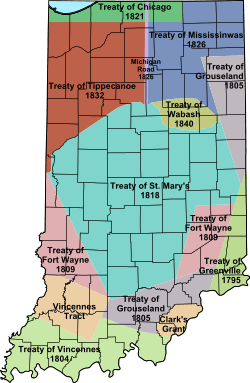Treaty of Fort Wayne (1803) facts for kids
 |
|
|---|---|
| Type | Recognition of American ownership of the Vincennes Tract |
| Signed | June 7, 1803 |
| Location | Fort Wayne, Indiana Territory |
| Effective | December 26, 1803 |
| Condition | Transfer of money and goods to natives; US to relinquish land claims in adjacent territory |
| Signatories | |
| Parties |
|
| Language | English |
The Treaty of Fort Wayne was an important agreement between the United States government and several groups of Native American tribes. This treaty was signed on June 7, 1803. It officially became active on December 26, 1803. The main goal of the treaty was to clearly mark the borders of a land area known as the Vincennes Tract. This land had been given to the United States in an earlier agreement, the Treaty of Greenville in 1795.
Contents
Who Signed the Treaty of Fort Wayne?
For the United States, the treaty was negotiated by William Henry Harrison. At that time, he was the governor of the Indiana Territory. He was also in charge of Native American affairs for the U.S. government in that region.
The Native American tribes were represented by their chiefs and important warriors. These included leaders from the Delawares, Shawnee, Potowatomi, Miami, and Kickapoo tribes. Other groups like the Eel River band of Miami, the Weas, Piankeshaws, and Kaskaskias also had representatives.
Some of the well-known Native American leaders who signed the treaty were:
- Little Turtle (also known as Meseekunnoghquoh or Michikinikwa), a leader for the Miamis.
- Topinabee (also known as Tuthinipee), a leader for the Potawatomi.
- Winnemac (also known as Catfish), another leader for the Potawatomi.
- Bukongehelas, a leader for the Delawares.
What Land Was Defined in the Treaty?
The first part of the treaty focused on setting clear borders for the Vincennes Tract. This land was located around Fort Vincennes on the Wabash River. The United States had already claimed this land in the 1795 Treaty of Greenville.
This land had a long history. It was first bought from the tribes by the Kingdom of France. Then, in 1763, it was given to Great Britain. Finally, in 1783, it became part of the United States. The Vincennes Tract was a rectangular area. It covered about 160,000 acres (about 647 square kilometers).
What Other Agreements Were Made?
In the second part of the treaty, the United States agreed to give up any claims to land right next to the Vincennes Tract. This meant the U.S. would not try to take more land in those specific areas.
Another important agreement was about a salt spring. The United States gained control of a salt spring located near the Saline Creek. This creek flows into the Ohio River. The U.S. also received about 4 square miles (about 10 square kilometers) of land around the spring. In return, the U.S. promised to give the Native American tribes 150 bushels (about 5.3 cubic meters) of salt every year.
The treaty also allowed the United States to set up three special areas of land. These areas were meant for building places where travelers could rest. These rest stops would be along the main roads between Vincennes and Kaskaskia, and between Vincennes and Clarksville. The size of these areas would be decided later with the Kickapoo, Eel River band of Miami, Wea, Piankeshaw, and Kaskaskia tribes.
Finally, the treaty included a rule about changing the borders. If it turned out that American settlements were accidentally built on Native American land, the borders could be adjusted. If land was taken from the tribes this way, an equal amount of land would be given back to them. This new land would be added to the east or west end of the Vincennes Tract.
Later Treaties Connected to This Agreement
After the Treaty of Fort Wayne, other agreements were made. On August 7, 1803, the Eel River band of Miami, Wyandot, Piankeshaw, Kaskaskia, and Kickapoo tribes agreed to the parts of the treaty that allowed for the building of traveler rest stops.
Later, in August 1805, two more treaties were signed in Vincennes. In these treaties, the Delawares and Piankeshaw tribes gave up their claims to lands south of the Vincennes Tract.

